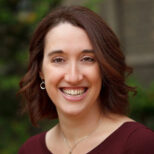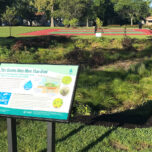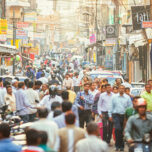September 30, 2022 — 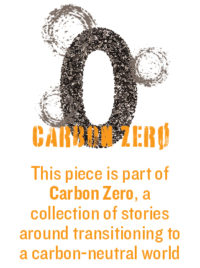 The stark, Brutalist-style buildings in Washington, D.C.’s Van Ness neighborhood seem an unlikely target for sustainability retrofitting. But when the campus of the historically Black University of the District of Columbia (UDC) began to show signs of deterioration, the administration decided to go beyond just fixing things and instead use the upgrade as an opportunity to both boost and teach not only on environmental, but also social, sustainability.
The stark, Brutalist-style buildings in Washington, D.C.’s Van Ness neighborhood seem an unlikely target for sustainability retrofitting. But when the campus of the historically Black University of the District of Columbia (UDC) began to show signs of deterioration, the administration decided to go beyond just fixing things and instead use the upgrade as an opportunity to both boost and teach not only on environmental, but also social, sustainability.
Founded in 1851 and now consisting of several small campuses throughout the city, UDC is the city’s only public university. It’s also unusual in that it’s a land grant university entirely located within an urban area and focused on urban agriculture. The student body includes not only traditional undergraduate and graduate students, but also those enrolled in workforce development, community college and other programs for nontraditional students.
In operation since 1968, the buildings of the Van Ness campus, lining one of D.C.’s busiest thoroughfares and abutting a diplomatic enclave of a dozen or so embassies, were in varying need of repair. Rather than simply maintain them, college officials saw an opportunity to make the university more resilient, and in doing so, turn it into a laboratory for students to learn sustainable practices.
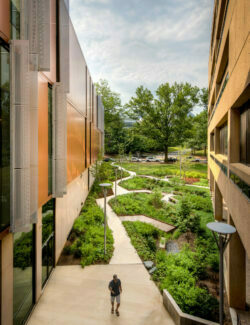
One of the most visible symbols of the new focus on sustainability with an educational emphasis at UDC is a LEED Platinum–certified student center. Photo courtesy of the University of the District of Columbia
“This is a university that doesn’t have a lot of notoriety in land-grant country. … So we said, how do we distinguish ourselves in a meaningful way?” says Sabine O’Hara, director of the doctorate program in urban leadership and entrepreneurship in the university’s College of Agriculture, Urban Sustainability, and Environmental Sciences (CAUSES). “And the answer we came up with, especially because of the student body that we have, is that it needs to be totally integrated, and it needs to take the living learning environment of these students seriously.”
“All of UDC is a lab for the students, the community and the city,” says Javier Dussan, UDC’s vice president of facilities and real estate management.
Rooftop Food Lab
One of the most visible symbols of the new focus on sustainability with an educational emphasis is a LEED Platinum–certified student center. Completed in 2016, it’s part of a partnership with the District government to train students in best practices for environmentally friendly building operations and maintenance.
“They learn but also live the consequences of having a sustainable building on campus,” Dussan says. “The real impact is to have the opportunity to say to students, ‘This is what a LEED Platinum building is, and it’s yours to use.’”
Less visible changes have also taken place in recent years and are ongoing. An aging roof was replaced with a green one, including a robust urban gardening space, with the help of the architecture master class. The roof extends the university’s food production and laboratory and research space by nearly a half-acre (0.2-hectares) complementing the university’s 143-acre (58-hectare) research and teaching farm just outside the city, and five food hub sites that provide training as well as fresh produce in food deserts throughout the District. Students working at the university’s community farmers market, food bank or related projects receive their food safety certification.
“We started the food hubs because we found it was difficult to get people out to the farm,” says Harris Trobman, the university’s green infrastructure project specialist. “Our focus isn’t on growing the most amount of food, but on treating each one like a museum of sorts, a small laboratory, with demonstration sites, experimental sites, to show what’s possible.”
Meanwhile, students in the water and resources management program worked on the installation and ongoing maintenance of a project to address flooding on campus. During heavy storms, runoff from the roof of below-ground parking garage would flood campus buildings. Now, a 92,000-square-foot (8,500-square-meter) plaza deck, built above the parking garage, is covered in permeable pavers that act as a pretreatment for stormwater, which is then conveyed into three, 5,000-gallon (19,000-liter) cisterns.
Tangible Benefits
In the District, the unemployment rate for Black residents is 12.5% — more than seven times the unemployment rate for white residents. UDC partners with the District’s Department of Energy and Environment (DOEE), DC Water, DC Solar, and other local and federal agencies to train underemployed and unemployed people in the District to qualify for certifications like that from the National Green Infrastructure Certification Program, and then place them in sustainability jobs with the partners.
“We have more successful graduation rates [of our workforce development students] than a lot of other programs in the nation, even though we take students who only have a high school diploma and are either underemployed or unemployed, and they compete with people who have a landscape architecture degree,” O’Hara says. “Once they pass the [green national infrastructure exam] they then are equipped to do rain garden design installation and maintenance and other related green infrastructure projects.”
Some of these initiatives, including solar panels and water infrastructure at the Van Ness and other campuses, have tangible financial benefits. Cisterns in Van Ness capture more water than the campus uses, and the extra can readily be used for additional community gardens or agricultural programs, or traded for local or national conservation credits. Trobman says UDC’s Bertie Backus campus, across town from Van Ness and home to the university’s nursing programs, is expecting a nearly US$13,000 credit for water conservation from DOEE after replacing old turf with native landscaping and adding cisterns.
The city will be providing other credits for solar power at various campuses. As part of an agreement with the city for funding and other support for the UDC sustainability initiatives, the credits are earmarked for student scholarships in any discipline, which provides yet another opportunity for students to learn about and engage in sustainability initiatives, even if they’re not directly involved in the on-campus programs themselves.
“A student will be able to say, ‘I’m going to UDC because a solar panel was installed,’” Dussan says. “It’s linking this to someone’s future. That’s not an easy linkage to make, but we need to do it.”
It’s a linkage O’Hara says more universities will be compelled to create both for their own buildings’ resiliency and for the future career opportunities of their students. “Campuses will have to make more and more investments in green infrastructure. Energy is not getting cheaper. We’re all experiencing either severe droughts or floods and there seems to be very little in between,” she says. “Campuses will have to adapt their infrastructures to say, ‘How can we do better with stormwater management?’ ‘How do we absorb water runoff?’ ‘How do we mitigate heat?’”
She continues with a recommendation for other universities: “Every time you do a project like this where you improve the campus infrastructure to become more resilient, turn it into a project for your students.”
Editor’s note: Molly McCluskey is a journalist based in Washington, D.C. and holds the LEED Green Associate certification.
Related Posts
Ensia shares solutions-focused stories free of charge through our online magazine and partner media. That means audiences around the world have ready access to stories that can — and do — help them shape a better future. If you value our work, please show your support today.
Yes, I'll support Ensia!
